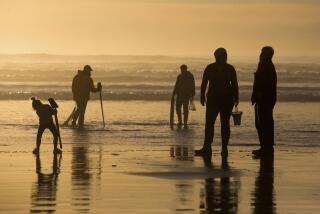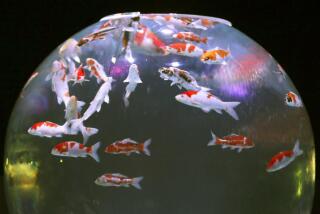The In-Between Years
- Share via
In the 1920s, when the West Coast’s Olympia oyster was all but wiped out, an oyster from Japan called Crassostrea gigas, or the Pacific oyster, was brought to the Pacific Northwest in hopes that it could revive a once-thriving industry.
Oyster growers imported cases of gigas shell from Japan, then spread the shells on existing oyster beds. What good was the shell? Minuscule oysters were attached to each shell, and they grew in a couple of years into big clumps of oysters. These oyster clumps couldn’t be sold to be eaten on the half-shell; they were too ungainly. Instead they were hauled by the truckload to shucking sheds, where the clumps were hammered apart and the meats removed and put up in jars or steamed and tinned for export.
Manila clams piggy-backed their way into Pacific Northwest waters from Japan with the gigas oysters; so did some pests. But by and large, it was one of the great intercontinental food transplants of history.
By the 1940s there were enough Pacific oysters living in Pacific Northwest waters that oystermen could take their oyster shells, called cultch, to one of two local bays when the temperature was just right and capture the spat, as the free-floating oyster larvae is called. Cultch with attached spat is called “seed.” Pity, of course, the poor Olympia native oyster, Ostrea lurida, whose natural habitat was pretty much smothered in an excess of gigas oysters. Fortunately, in some areas of South Puget Sound, Olympia oysters survived.
After World War II, the Kumamoto oyster (Crassostrea sikamea) was imported from Japan in an attempt to replace the small Olympia. The Kumo, as they are called in oyster bars, was small, less than two inches long, with a deep, uniform cup. The Olympia shell is about the size of a 50-cent piece but is much flatter.
The Olympia has a sharp, coppery taste that follows on the heels of its sweet briny kiss; the Kumo can be sweeter and nuttier--and mild. An easy oyster, in other words. But the oystermen hated it for being small and difficult to handle: too expensive to open for the shucked meat trade. So the imports were left on the oyster beds of the Pacific Northwest to grow or die as they pleased. They were discovered again, later, when the tides of oyster technology and taste had changed.
Similarly, the Eastern oyster, Crassostrea virginica, king of the half-shell trade, was brought in. But it too failed. Pacific Northwest water never gets warm enough for this oyster to spawn. And when oyster disease and pest problems became apparent in Eastern oyster beds, it was banned altogether from Pacific Northwest water.
More to Read
Sign up for Essential California
The most important California stories and recommendations in your inbox every morning.
You may occasionally receive promotional content from the Los Angeles Times.













